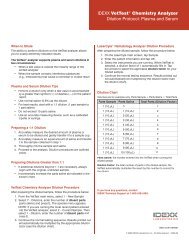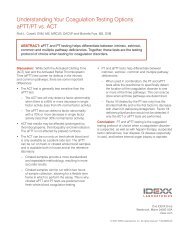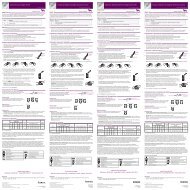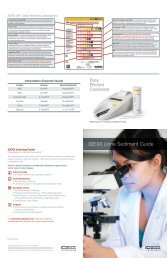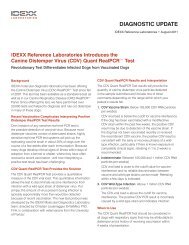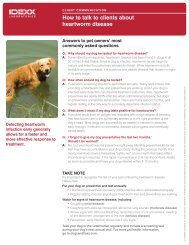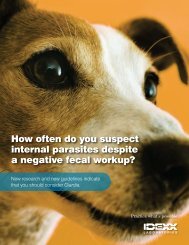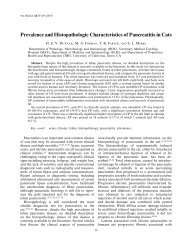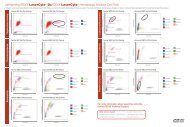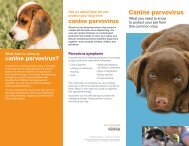Assessment of NTproBNP Concentration in Dogs - IDEXX ...
Assessment of NTproBNP Concentration in Dogs - IDEXX ...
Assessment of NTproBNP Concentration in Dogs - IDEXX ...
Create successful ePaper yourself
Turn your PDF publications into a flip-book with our unique Google optimized e-Paper software.
SMALL ANIMALS/EXOTICuse subjective diagnostic term<strong>in</strong>ology, such as unlikely,possible, and very likely, to convey assay results. 28,29,33Results that fall <strong>in</strong>to the possible category automaticallytrigger additional diagnostic <strong>in</strong>vestigation to <strong>in</strong>crease(or decrease) the confidence <strong>of</strong> diagnosis. Thesealgorithms underscore the diagnostic limitations <strong>of</strong> natriureticpeptide assay <strong>in</strong> both humans and dogs, andNT-proBNP assay results should complement and notreplace the medical history, physical exam<strong>in</strong>ation, andconventional diagnostic test<strong>in</strong>g.In our study, most <strong>of</strong> the patient population comprisedgeriatric small-breed dogs, and as such, manydogs had concurrent cardiac and respiratory tractdisease or pulmonary hypertension. Results <strong>of</strong> previousstudies 2,24 <strong>in</strong>dicate that, although circulat<strong>in</strong>gNT-proBNP concentration is generally low <strong>in</strong> dogs withasymptomatic heart disease, it can be markedly high<strong>in</strong> <strong>in</strong>dividual dogs. These high concentrations woulddecrease the discrim<strong>in</strong>atory ability <strong>of</strong> NT-proBNP <strong>in</strong>dogs with concurrent cardiac and respiratory tract disease.Indeed, <strong>in</strong> our study, the discrim<strong>in</strong>atory power <strong>of</strong>NT-proBNP was lower <strong>in</strong> dist<strong>in</strong>guish<strong>in</strong>g between group1 and 3 dogs versus between group 1 and 2 dogs. Ourresults <strong>in</strong>dicate that serum NT-proBNP concentration ishigh <strong>in</strong> dogs with respiratory tract disease and pulmonaryhypertension. In humans, NT-proBNP is producedby the right ventricle <strong>in</strong> response to myocyte stress, 34,35and although the high plasma NT-proBNP concentrationsare generally lower than for diseases that primarilyaffect the left ventricle, 36 serum NT-proBNP concentrationis correlated with severity <strong>of</strong> right ventriculardysfunction and pressure overload. 33–36 In our study,dogs with primary respiratory tract disease and pulmonaryhypertension had a 3-fold <strong>in</strong>crease <strong>in</strong> the medianserum NT-proBNP concentration, compared withdogs with respiratory tract disease without pulmonaryhypertension. This phenomenon may contribute to alikelihood <strong>of</strong> false-positive result for congestive heartfailure (ie, the diagnosis <strong>of</strong> congestive heart failure <strong>in</strong>dogs with primary respiratory tract disease as the cause<strong>of</strong> respiratory signs). This concept <strong>of</strong> false-positive resultfor congestive heart failure on the basis <strong>of</strong> NT-proB-NP assay results <strong>in</strong> patients with respiratory and cardiacdisease is <strong>in</strong>trigu<strong>in</strong>g. On one hand, the production <strong>of</strong>NT-proBNP <strong>in</strong> response to pulmonary hypertensionconfounds the determ<strong>in</strong>ation <strong>of</strong> the cause <strong>of</strong> respiratorysigns. On the other hand, assay results <strong>in</strong> thispopulation should not be summarily discounted, as <strong>NTproBNP</strong>is strongly correlated to mortality and morbidityrates. In human patients with pulmonary hypertension,a serum NT-proBNP concentration > 1,400 pmol/L hada sensitivity <strong>of</strong> 100% for predict<strong>in</strong>g the 3-year mortalityrate and, <strong>in</strong> this respect, was superior to other parameters,such as exercise test results, pulmonary vascularresistance, functional cl<strong>in</strong>ical class, and cardiac <strong>in</strong>dex. 37Thus, NT-proBNP assay results may have importantprognostic value <strong>in</strong> dyspneic patients despite their potentialto confound diagnosis <strong>of</strong> etiology.In conclusion, serum NT-proBNP concentration<strong>in</strong> dogs with respiratory signs <strong>in</strong> the present studyhelped to differentiate between congestive heart failureand primary respiratory tract disease as the underly<strong>in</strong>gcause. The presence <strong>of</strong> concurrent cardiac and respiratorytract disease or pulmonary hypertension couldconfound diagnosis. The NT-proBNP assay should beused <strong>in</strong> conjunction with medical history, physical exam<strong>in</strong>ationf<strong>in</strong>d<strong>in</strong>gs, and other diagnostic test resultsto help achieve a diagnosis for the cause <strong>of</strong> respiratorysigns <strong>in</strong> dogs.a. Can<strong>in</strong>e CardioCare NT-proBNP, Veter<strong>in</strong>ary Diagnostics Institute,Irv<strong>in</strong>e, Calif.b. GraphPad Prism, version 4.0, Graph Pad S<strong>of</strong>tware Inc, San Diego,Calif.c. MedCalc, version 9.5.1.0, MedCalc S<strong>of</strong>tware, Mariakerke, Belgium.d. Wess G, Timper N, Hirschberger J. The utility <strong>of</strong> NT-proBNPto differentiate cardiac and non-cardiac causes <strong>of</strong> cough<strong>in</strong>g ordyspnea <strong>in</strong> dogs (abstr). J Vet Intern Med 2007;21:608.References1. Boswood A, Dukes-McEwan J, Loureiro J, et al. The diagnosticaccuracy <strong>of</strong> different natriuretic peptides <strong>in</strong> the <strong>in</strong>vestigation <strong>of</strong>can<strong>in</strong>e cardiac disease. J Small Anim Pract 2008;49:26–32.2. Oyama MA, Fox PR, Rush JE, et al. Cl<strong>in</strong>ical utility <strong>of</strong> serum N-term<strong>in</strong>al pro-B-type natriuretic peptide concentration for identify<strong>in</strong>gcardiac disease <strong>in</strong> dogs and assess<strong>in</strong>g disease severity.J Am Vet Med Assoc 2008;232:1496–1503.3. de Bold AJ, Ma KK, Zhang Y, et al. The physiological and pathophysiologicalmodulation <strong>of</strong> the endocr<strong>in</strong>e function <strong>of</strong> the heart.Can J Physiol Pharmacol 2001;79:705–714.4. Braunwald E. Biomarkers <strong>in</strong> heart failure. N Engl J Med2008;358:2148–2159.5. Maisel A, Mueller C, Adams K Jr, et al. State <strong>of</strong> the art: us<strong>in</strong>gnatriuretic peptide levels <strong>in</strong> cl<strong>in</strong>ical practice. Eur J Heart Fail2008;10:824–839.6. Maisel AS. The diagnosis <strong>of</strong> acute congestive heart failure: role<strong>of</strong> BNP measurements. Heart Fail Rev 2003;8:327–334.7. McCullough PA, Nowak RM, McCord J, et al. B-type natriureticpeptide and cl<strong>in</strong>ical judgment <strong>in</strong> emergency diagnosis <strong>of</strong> heartfailure: analysis from Breath<strong>in</strong>g Not Properly (BNP) Mult<strong>in</strong>ationalStudy. Circulation 2002;106:416–422.8. Mueller C, Scholer A, Laule-Kilian K, et al. Use <strong>of</strong> B-type natriureticpeptide <strong>in</strong> the evaluation and management <strong>of</strong> acute dyspnea.N Engl J Med 2004;350:647–654.9. Januzzi JL Jr, Camargo CA, Anwarudd<strong>in</strong> S, et al. The N-term<strong>in</strong>alPro-BNP <strong>in</strong>vestigation <strong>of</strong> dyspnea <strong>in</strong> the emergency department(PRIDE) study. Am J Cardiol 2005;95:948–954.10. Moe GW, Howlett J, Januzzi JL, et al. N-term<strong>in</strong>al pro-B-type natriureticpeptide test<strong>in</strong>g improves the management <strong>of</strong> patientswith suspected acute heart failure: primary results <strong>of</strong> the Canadianprospective randomized multicenter IMPROVE-CHFstudy. Circulation 2007;115:3103–3110.11. Alibay Y, Beauchet A, El Mahmoud R, et al. Plasma N-term<strong>in</strong>al probra<strong>in</strong>natriuretic peptide and bra<strong>in</strong> natriuretic peptide <strong>in</strong> assessment<strong>of</strong> acute dyspnea. Biomed Pharmacother 2005;59:20–24.12. Pemberton CJ, Johnson ML, Yandle TG, et al. Deconvolutionanalysis <strong>of</strong> cardiac natriuretic peptides dur<strong>in</strong>g acute volumeoverload. Hypertension 2000;36:355–359.13. Buchanan JW, Bücheler J. Vertebral scale system to measure can<strong>in</strong>eheart size <strong>in</strong> radiographs. J Am Vet Med Assoc 1995;206:194–199.14. Hansson K, Haggstrom J, Kvart C, et al. Interobserver variability<strong>of</strong> vertebral heart size measurements <strong>in</strong> dogs with normal andenlarged hearts. Vet Radiol Ultrasound 2005;46:122–130.15. Hansson K, Haggstrom J, Kvart C, et al. Left atrial to aortic root<strong>in</strong>dices us<strong>in</strong>g two-dimensional and M-mode echocardiography<strong>in</strong> cavalier K<strong>in</strong>g Charles spaniels with and without left atrialenlargement. Vet Radiol Ultrasound 2002;43:568–575.16. Sahn DJ, DeMaria A, Kisslo J, et al. Recommendations regard<strong>in</strong>gquantitation <strong>in</strong> M-mode echocardiography: results <strong>of</strong> a survey<strong>of</strong> echocardiographic measurements. Circulation 1978;58:1072–1083.17. DeFrancesco TC, Rush JE, Rozanski EA, et al. Prospective cl<strong>in</strong>icalevaluation <strong>of</strong> an ELISA B-type natriuretic peptide assay <strong>in</strong>1324 Scientific Reports JAVMA, Vol 235, No. 11, December 1, 2009



